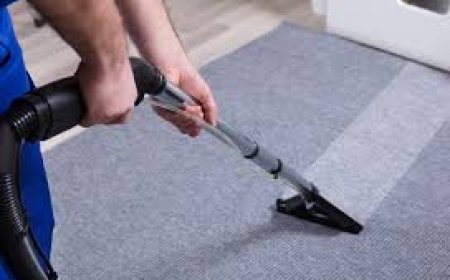Energy-Efficient Commercial Ventilation Solutions for Green Buildings

In the era of sustainability and eco-conscious construction, energy-efficient commercial ventilation systems are playing a pivotal role in transforming buildings into greener, more sustainable spaces. As green building certifications, like LEED (Leadership in Energy and Environmental Design), become increasingly important for businesses and developers, the demand for efficient, cost-effective ventilation solutions is at an all-time high.
Ventilation systems are essential for maintaining healthy indoor air quality (IAQ) and regulating temperature and humidity within commercial spaces. However, traditional ventilation methods often come at a high energy cost. The key challenge for modern architects, builders, and facility managers is to balance efficient air circulation with minimal environmental impact. Let’s dive into the best practices, technologies, and solutions for energy-efficient commercial ventilation in green buildings.
The Need for Energy-Efficient Ventilation in Green Buildings
Buildings account for a significant portion of global energy consumption, and commercial spaces are no exception. According to the U.S. Energy Information Administration (EIA), commercial buildings are responsible for nearly 20% of total energy consumption in the United States. A major contributor to this is the energy required to heat, cool, and ventilate these spaces. Improving the efficiency of commercial ventilation systems can therefore have a massive impact on reducing overall energy use, lowering carbon footprints, and cutting operational costs.
Green buildings are designed to reduce their environmental impact across various dimensions, including energy efficiency, water conservation, and sustainable materials. Commercial ventilation plays a crucial role in this framework by ensuring that the building remains comfortable and healthy without wasting energy.
Key Features of Energy-Efficient Commercial Ventilation
1. Demand-Controlled Ventilation (DCV)
Demand-Controlled Ventilation (DCV) is one of the most effective strategies for optimizing energy usage in commercial buildings. Unlike traditional systems that operate at a fixed rate, DCV adjusts the amount of outdoor air brought into the building based on real-time occupancy and air quality. Using sensors that detect CO2 levels, humidity, and temperature, DCV ensures that only the required amount of ventilation is provided.
This approach significantly reduces energy consumption since it avoids over-ventilating when the space is unoccupied or when the air quality is already optimal. Additionally, by reducing the need for heating or cooling large volumes of outdoor air, DCV systems improve the overall efficiency of the HVAC system.
2. Heat Recovery Ventilation (HRV)
Heat Recovery Ventilation (HRV) is another technology that helps in achieving energy efficiency in commercial ventilation. HRVs transfer heat from stale, outgoing air to fresh, incoming air, which helps in pre-conditioning the air entering the building. This means that during winter, the heat from the warm indoor air can be transferred to the cold incoming air, and vice versa in the summer, reducing the need for energy-intensive heating or cooling.
The result is a more efficient HVAC system, which reduces energy costs and contributes to a more comfortable indoor environment. This system is particularly useful in regions with extreme climates, where heating and cooling demands are significant.
3. Variable Air Volume (VAV) Systems
Variable Air Volume (VAV) systems are designed to regulate the airflow based on the changing cooling or heating demand within a space. Unlike traditional systems that deliver a constant volume of air, VAV systems adjust the volume of conditioned air delivered to each zone based on its temperature or occupancy.
This variability in airflow allows the system to be much more energy-efficient, as it avoids delivering excessive amounts of air to areas that don’t require it. VAV systems are particularly suited for large commercial spaces where different areas experience different heating and cooling loads.
4. Natural Ventilation
When designing green buildings, one of the most sustainable solutions is to harness natural ventilation. This involves strategically placing windows, vents, and air shafts to allow for the free flow of fresh air through the building. By using the wind and thermal buoyancy (the natural upward movement of hot air), natural ventilation systems can significantly reduce the reliance on mechanical ventilation and the energy required for cooling.
However, natural ventilation requires careful design and integration, as it may not be viable in every location or climate. It works best in climates where outdoor air quality is good, and the temperature doesn’t fluctuate drastically.
5. Energy-Efficient Ventilation Fans
Choosing energy-efficient ventilation fans is an easy but often overlooked way to reduce energy consumption. Modern, high-efficiency fans use advanced motors, better materials, and improved aerodynamics to minimize energy loss. These fans use less power to move the same amount of air as older models and can often be paired with smart controls to optimize their performance based on real-time needs.
Furthermore, ECM (Electronically Commutated Motors), which are more efficient than traditional AC motors, are increasingly being used in commercial ventilation systems. These motors offer the flexibility to adjust speeds based on demand, reducing energy consumption and wear and tear on the system.
Integrating Smart Controls for Enhanced Efficiency
One of the emerging trends in energy-efficient commercial ventilation systems is the integration of smart controls. By using Internet of Things (IoT) devices and building management systems (BMS), smart controls can optimize ventilation in real-time. These systems can monitor indoor air quality, temperature, humidity, occupancy levels, and even outdoor weather conditions to adjust ventilation accordingly.
For example, if a building’s CO2 levels rise, the system can automatically increase ventilation to improve air quality. Conversely, if the building is empty, it can reduce ventilation to save energy. Advanced predictive algorithms can even anticipate the building’s ventilation needs based on historical data, occupancy patterns, and weather forecasts.
Benefits of Energy-Efficient Commercial Ventilation
-
Reduced Energy Consumption: Energy-efficient systems help reduce the overall energy consumption of a building, leading to lower utility bills and a smaller carbon footprint.
-
Improved Indoor Air Quality: Proper ventilation ensures the removal of pollutants, allergens, and excess moisture, improving the health and comfort of occupants.
-
Long-Term Cost Savings: Although the upfront costs of energy-efficient systems can be higher, the long-term savings on energy bills and reduced maintenance costs make them a wise investment for building owners and managers.
-
Environmental Impact: By reducing energy consumption, energy-efficient ventilation systems contribute to the reduction of greenhouse gas emissions, helping businesses align with sustainability goals and comply with green building standards.
Conclusion
As the construction industry continues to prioritize sustainability, energy-efficient commercial ventilation systems are becoming a cornerstone of green buildings. With technologies like demand-controlled ventilation, heat recovery systems, and smart controls, these systems not only improve energy efficiency but also contribute to better indoor air quality and occupant comfort.
Investing in the right ventilation solutions is not just a trend—it’s a necessity for businesses and building owners looking to reduce operating costs, minimize their environmental impact, and create healthier, more comfortable spaces. By embracing these innovative ventilation technologies, we can ensure that our commercial buildings are not only efficient but also aligned with the growing movement toward sustainability in architecture and design.
What's Your Reaction?
 Like
0
Like
0
 Dislike
0
Dislike
0
 Love
0
Love
0
 Funny
0
Funny
0
 Angry
0
Angry
0
 Sad
0
Sad
0
 Wow
0
Wow
0























































